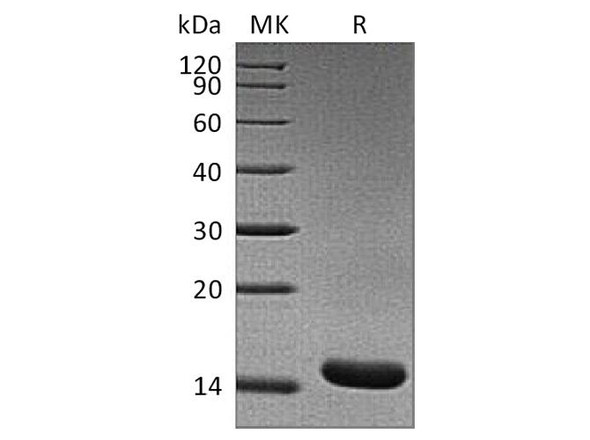Cytokines Recombinant Proteins
Rat TNF a Recombinant Protein (RPPB0995)
- SKU:
- RPPB0995
- Product Type:
- Recombinant Protein
- Species:
- Rat
- Uniprot:
- P16599
- Research Area:
- Cytokines
Description
| Product Name: | Rat TNF a Recombinant Protein |
| Product Code: | RPPB0995 |
| Size: | 20µg |
| Species: | Rat |
| Target: | TNF a |
| Synonyms: | Tumor Necrosis Factor-alpha, TNF a His, Cachectin, TNF-alpha, Tumor necrosis factor ligand superfamily member 2, TNF-a, N-terminal fragment, NTF, Intracellular domain 1, Intracellular domain 2, ICD2, C-domain 1, C-domain 2, Tumor necrosis factor, soluble form, Tnfa, Tnfsf2, RATTNF, Tnfa. |
| Source: | Escherichia Coli |
| Physical Appearance: | Sterile Filtered clear solution. |
| Formulation: | TNF a protein solution (1mg/ml) containing Phosphate Buffer Saline (pH7.4), 10% glycerol and 1mM DTT. |
| Stability: | Store at 4°C if entire vial will be used within 2-4 weeks. Store, frozen at -20°C for longer periods of time. For long term storage it is recommended to add a carrier protein (0.1% HSA or BSA).Avoid multiple freeze-thaw cycles. |
| Purity: | Greater than 90.0% as determined by analysis by SDS-PAGE. |
| Amino Acid Sequence: | MGSSHHHHHH SSGLVPRGSH MGSHMLRSSS QNSSDKPVAH VVANHQAEEQ LEWLSQRANA LLANGMDLKD NQLVVPADGL YLIYSQVLFK GQGCPDYVLL THTVSRFAIS YQEKVSLLSA IKSPCPKDTP EGAELKPWYE PMYLGGVFQL EKGDLLSAEV NLPKYLDITE SGQVYFGVIA L |
Tumor necrosis factor is a cytokine involved in systemic inflammation and is a member of a group of cytokines that all stimulate the acute phase reaction. TNF is mainly secreted by macrophages. TNF causes apoptotic cell death, cellular proliferation, differentiation, inflammation, tumorigenesis and viral replication, TNF is also involved in lipid metabolism, and coagulation. TNF's primary role is in the regulation of immune cells.Dysregulation and, in particular, overproduction of TNF have been implicated in a variety of human diseases- autoimmune diseases, insulin resistance, and cancer.
TNF a Rat Recombinant produced in E.Coli is a single, non-glycosylated polypeptide chain containing 181 amino acids (80-235a.a.) and having a molecular mass of 19.9kDa.TNF a is fused to a 25 amino acid His-tag at N-terminus & purified by proprietary chromatographic techniques.
| UniProt Protein Function: | TNF-a: Cytokine that binds to TNFRSF1A/TNFR1 and TNFRSF1B/TNFBR. It is mainly secreted by macrophages and can induce cell death of certain tumor cell lines. It is potent pyrogen causing fever by direct action or by stimulation of interleukin-1 secretion and is implicated in the induction of cachexia, Under certain conditions it can stimulate cell proliferation and induce cell differentiation. Homotrimer. Interacts with SPPL2B. Belongs to the tumor necrosis factor family. |
| UniProt Protein Details: | Protein type:Motility/polarity/chemotaxis; Membrane protein, integral; Cytokine; Apoptosis Cellular Component: extracellular space; recycling endosome; cell surface; integral to plasma membrane; integral to membrane; plasma membrane; intracellular; external side of plasma membrane; phagocytic cup; lipid raft Molecular Function:identical protein binding; protease binding; cytokine activity; tumor necrosis factor receptor binding Biological Process: extracellular matrix organization and biogenesis; positive regulation of nitric oxide biosynthetic process; positive regulation of NFAT protein import into nucleus; activation of MAPK activity; positive regulation of apoptosis; positive regulation of transcription, DNA-dependent; positive regulation of caspase activity; positive regulation of translational initiation by iron; positive regulation of membrane protein ectodomain proteolysis; activation of NF-kappaB transcription factor; positive regulation of MAP kinase activity; cellular extravasation; tumor necrosis factor-mediated signaling pathway; positive regulation of phagocytosis; negative regulation of interleukin-6 production; JNK cascade; negative regulation of osteoblast differentiation; positive regulation of action potential; embryonic gut development; negative regulation of protein complex disassembly; response to drug; positive regulation of cytokine production; positive regulation of heterotypic cell-cell adhesion; positive regulation of mitosis; response to virus; positive regulation of interleukin-6 production; glucose metabolic process; negative regulation of cytokine secretion during immune response; positive regulation of protein transport; DNA damage response, signal transduction resulting in induction of apoptosis; response to mechanical stimulus; defense response to bacterium; positive regulation of transcription from RNA polymerase II promoter; skeletal muscle contraction; sequestering of triacylglycerol; positive regulation of JNK cascade; negative regulation of transcription from RNA polymerase II promoter; signal transduction; positive regulation of interleukin-18 production; chronic inflammatory response to antigenic stimulus; positive regulation of hair follicle development; negative regulation of cell proliferation; positive regulation of neuron apoptosis; protein kinase B signaling cascade; positive regulation of chronic inflammatory response to antigenic stimulus; inflammatory response; regulation of protein amino acid phosphorylation; transformed cell apoptosis; positive regulation of peptidyl-serine phosphorylation; humoral immune response; regulation of cell proliferation; positive regulation of protein kinase B signaling cascade; positive regulation of interferon-gamma production; positive regulation of programmed cell death; positive regulation of protein complex assembly; negative regulation of viral genome replication; response to hypoxia; regulation of insulin secretion; positive regulation of JNK activity; positive regulation of osteoclast differentiation; multicellular organismal development; response to glucocorticoid stimulus; response to lipopolysaccharide; positive regulation of NF-kappaB import into nucleus; osteoclast differentiation; regulation of immunoglobulin secretion; positive regulation of I-kappaB kinase/NF-kappaB cascade; positive regulation of interleukin-8 biosynthetic process; positive regulation of chemokine production; cell activation; detection of mechanical stimulus involved in sensory perception of pain; organ morphogenesis; defense response to Gram-positive bacterium; induction of apoptosis via death domain receptors; positive regulation of transcription factor activity; negative regulation of L-glutamate transport; response to activity; negative regulation of transcription, DNA-dependent; leukocyte migration; apoptosis; positive regulation of smooth muscle cell proliferation; defense response; positive regulation of synaptic transmission; response to radiation; regulation of protein secretion; regulation of osteoclast differentiation; negative regulation of lipid catabolic process; lipopolysaccharide-mediated signaling pathway; regulation of I-kappaB kinase/NF-kappaB cascade; caspase activation; positive regulation of humoral immune response mediated by circulating immunoglobulin; positive regulation of protein complex disassembly; calcium-mediated signaling; MAPKKK cascade; negative regulation of glucose import; positive regulation of chemokine biosynthetic process; protein import into nucleus, translocation; positive regulation of protein kinase activity; positive regulation of fever; activation of MAPKKK activity; positive regulation of protein amino acid phosphorylation; receptor biosynthetic process; leukocyte tethering or rolling; negative regulation of myoblast differentiation; positive regulation of inflammatory response; positive regulation of cytokine secretion |
| NCBI Summary: | acts as a cytokine; binds TNF receptors; plays a role in regulation of cell proliferation, induction of apoptosis, and inflammatory response [RGD, Feb 2006] |
| UniProt Code: | P16599 |
| NCBI GenInfo Identifier: | 135938 |
| NCBI Gene ID: | 24835 |
| NCBI Accession: | P16599.1 |
| UniProt Secondary Accession: | P16599,Q6EE11, Q9JI26, Q9JI27, |
| UniProt Related Accession: | P16599 |
| Molecular Weight: | 25,806 Da |
| NCBI Full Name: | Tumor necrosis factor |
| NCBI Synonym Full Names: | tumor necrosis factor |
| NCBI Official Symbol: | Tnf�� |
| NCBI Official Synonym Symbols: | Tnfa; RATTNF; TNF-alpha�� |
| NCBI Protein Information: | tumor necrosis factor; cachectin; tumor necrosis factor alpha; tumor necrosis factor (TNF superfamily, member 2); tumor necrosis factor ligand superfamily member 2 |
| UniProt Protein Name: | Tumor necrosis factor |
| UniProt Synonym Protein Names: | Cachectin; TNF-alpha; Tumor necrosis factor ligand superfamily member 2; TNF-a |
| Protein Family: | Tumor necrosis factor |
| UniProt Gene Name: | Tnf�� |
| UniProt Entry Name: | TNFA_RAT |






